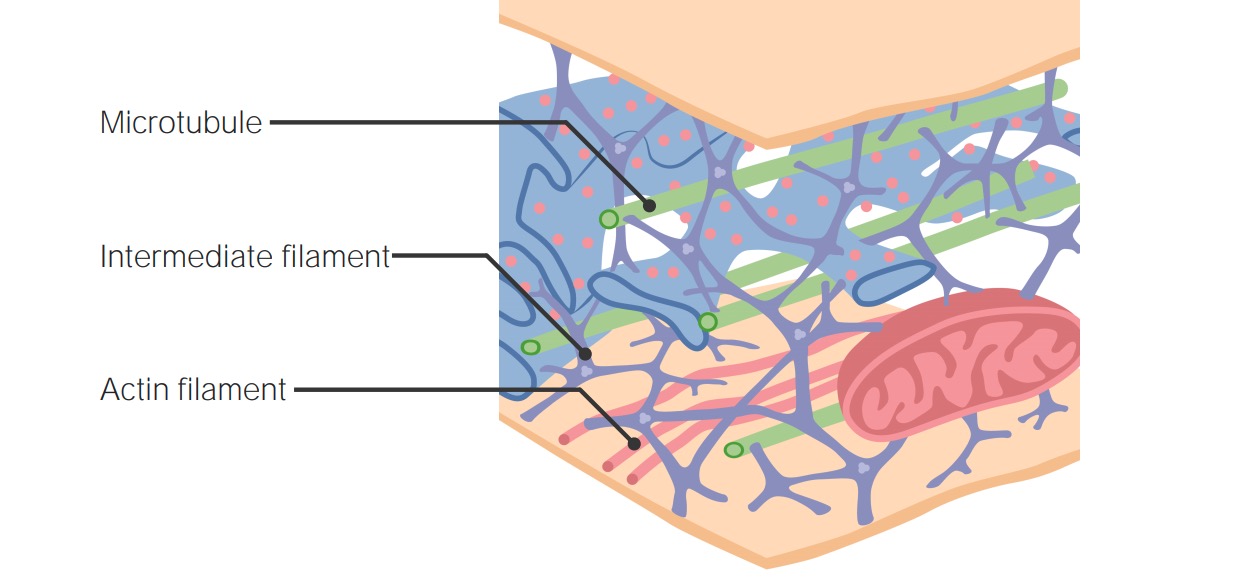Playlist
Show Playlist
Hide Playlist
Cytoskeleton: Actin Microfilaments, Intermediate Filaments, and Microtubule
-
Slides Cellular Pathology - Motility and Structure.pdf
-
Reference List Pathology.pdf
-
Download Lecture Overview
00:00 Alright, the next topic that we're gonna tackle here is motility and structure. 00:05 Again, these are part of the normal housekeeping functions that every cell needs to have and being able to move and being able to maintain your organization is really important not only for making sure you have the right shape but also making sure that your organelles are in the right place inside the cell. 00:24 With that, this is where we are in our roadmap. 00:28 We're talking about basic cell housekeeping functions. 00:31 We're on the fourth topic, motility and structure. 00:34 So, we're gonna dive right into the cytoskeleton and fundamentally, the proteins, and there are three basic forms of proteins that form a cytoskeleton. 00:42 They're going to maintain structure. 00:44 Remember early on that we talked about most cells not being round. 00:47 Most cells are cuboidal or columnar or flat or they are parametal and that's maintained largely by the actin microfilaments. 00:57 So, actin are a whole, just a huge number of a particular protein actin that polymerizes into long microfilaments. 01:08 So, each individual acting subunit is about 45 kilodaltons and there's lots and lots of globular actin. 01:17 We use it in fact as a way to calibrate protein expression. 01:23 We always, we will look at actin expression when we do various experiments looking at cells. 01:29 So, it's the most common intracellular protein. 01:32 And when it's in as a glob, it doesn't do much but when it polymerizes, it actually provides structure and function. 01:40 So, this is you're looking at a polymerized group of actin globules and it's very dynamic. 01:47 We add new globules, new individual subunits and subtract subunits all the time. 01:52 We can also have a number of proteins that can break the strands or make them branch in interesting ways. 01:59 So, the structure of the actin when it polymerizes, it's directional. 02:05 There is a positive end and a negative end and we are able to use them as tension elements meaning that we can pull on them and we can have effects on the architecture, the organization of the filaments. Alright. The next one is intermediate filaments. 02:28 These are slightly larger filaments. 02:30 They're not as dynamic as the actin microfilaments. 02:34 They don't add and subtract. 02:36 They're not directional but they're really important structural components. 02:41 So, they provide structural integrity and tensile strength. 02:47 So, we can pull on these very hard and they won't rip apart. It's like pulling on a rope. 02:53 And so, we can actually have multiple cells held together through cell-cell interactions as we'll see shortly connected to intermediate filaments and that provides a relatively strong network of cells all interacting together. 03:08 Those are the intermediate filaments. 03:10 And the third class of the cytoskeleton elements are the microtubules. 03:15 These are actually throughout the cell but as drawn here, this is demonstrating their major role. 03:23 They emanate from a structure called the centriole that lives in the vicinity of the nucleus and they emanate out towards the periphery of the cell. 03:32 They're gonna act as highways to bring proteins and other organelles to the periphery, to the plasma membrane and to bring things from the plasma membrane in towards the nucleus. 03:44 So, these are made of polymers of alpha and beta tubulin and they make a really big tubule, so, as opposed to the microfilament which is perhaps 10 nanometers. 03:56 These are on the order of 100 nanometers, so, they're much, much bigger, bigger tubules and they have multiple structures and functions. 04:05 So, they are dynamic. 04:07 So, that means that we can add and subtract the alpha and beta tubulin to these big structures and make them get larger or longer or shorter. They are directional. 04:17 So, there is a negative end that's in the centriole and there's a positive end out of the periphery of the cell. They are non-compressible. 04:24 So, the previous two elements were like ropes. You pulled on them. 04:28 There was tension. These are like tent poles. They -- you can't compress them. 04:33 So, they are non-compressible struts and they therefore provide structural integrity to the cell in that matter. 04:40 But as I said, they're also really important for intracellular movement as they're gonna be highways and we'll see how that works and they're also going to be involved in the process of pulling chromosomes apart. 04:51 They are the elements of the mitotic spindle in cell replication.
About the Lecture
The lecture Cytoskeleton: Actin Microfilaments, Intermediate Filaments, and Microtubule by Richard Mitchell, MD, PhD is from the course Cellular Housekeeping Functions.
Included Quiz Questions
What is the primary component of microfilaments?
- Actin
- Tubulin
- Connexin
- Desmin
- Vimentin
Which of the following best describes the intermediate filaments?
- They provide structural integrity.
- They are made of tubulin monomers.
- They are extremely dynamic.
- They are characterized by their non-compressible structure.
- They are assembled in a bi-directional pattern.
The microtubules play a primary role in...?
- ...intracellular movement.
- ...cell-cell interaction.
- ...cell locomotion.
- ...collagen synthesis.
- ...DNA synthesis.
Customer reviews
5,0 of 5 stars
| 5 Stars |
|
5 |
| 4 Stars |
|
0 |
| 3 Stars |
|
0 |
| 2 Stars |
|
0 |
| 1 Star |
|
0 |




